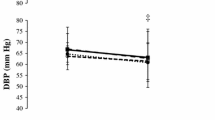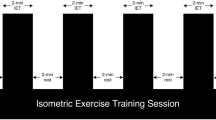Abstract
Purpose
Traditional resistance exercise decreases vagal tone up to 30 min after an acute bout of resistance exercise, which may increase the risk of cardiovascular events. However, the effects of resistance exercise with blood flow restriction (BFR) on autonomic modulation are unclear. To evaluate autonomic modulation after resistance exercise with and without BFR in resistance-trained men.
Methods
Eleven young men volunteered for the study. Autonomic modulation was assessed at rest, 15 (Rec 1), and 25 (Rec 2) minutes after low-load bench press with BFR (LL-BFR), traditional high-load bench press (HL), and a control (CON). Autonomic modulation assessments were expressed as natural logarithm (Ln), and included total power (LnTP), low-frequency power (LnLF), high-frequency power (LnHF), sympathovagal balance (LnLF/LnHF ratio), root mean square of the successive differences (LnRMSSD), and the proportion of intervals differing by > 50 ms from the preceding intervals (LnPNN50). A repeated measures ANOVA was used to evaluate conditions (LL-BFR, HL and CON) across time (Rest, Rec1, and Rec2) on autonomic modulation.
Results
There were significant condition by time interactions for LnTP, LnHF, and LnRMSSD such that they were reduced during recovery after LL-BFR and HL compared to Rest and CON. There were no interactions in the LnLF, LnLF/LnHF ratio, and LnPNN50.
Conclusions
These data suggest that LL-BFR and HL significantly alter autonomic modulation up to 30 min after exercise with significant reduction after HL compared to LL-BFR when exercise volume is equated.
Similar content being viewed by others
Abbreviations
- 1RM:
-
1-Repetition maximum
- ACSM:
-
American College of Sports Medicine
- BFR:
-
Blood flow restriction
- BMI:
-
Body mass index
- BP:
-
Blood pressure
- CON:
-
Control
- ECG:
-
Electrocardiogram
- HF:
-
High-frequency power
- HL:
-
Traditional high-load bench press
- HR:
-
Heart rate
- HRV:
-
Heart rate variability
- LL-BFR:
-
Low-load bench press with blood flow restriction
- Ln:
-
Natural logarithm
- LnHF:
-
Natural logarithm of high-frequency power
- LnLF:
-
Natural logarithm of low-frequency power
- LnPNN50:
-
Natural logarithm of number of normal to normal intervals which differed by > 50 ms from adjacent intervals divided by the total number of all normal to normal intervals
- LnRMSSD:
-
Natural logarithm of root mean square of successive differences of normal to normal intervals
- LnTP:
-
Natural logarithm of total power
- LF:
-
Low-frequency power
- NN:
-
Normal to normal intervals
- PAR-Q:
-
Physical Activity Readiness Questionnaire
- TP:
-
Total power
- PNN50:
-
Number of normal to normal intervals which differed by > 50 ms from adjacent intervals divided by the total number of all normal to normal intervals
- RMSSD:
-
Root mean square of successive differences of normal to normal intervals
References
Abe T, Kawamoto K, Yasuda T, Kearns CF, Midorikawa T, Sato Y (2005) Eight days KAATSU-resistance training improved sprint but not jump performance in collegiate male track and field athletes. Int J KAATSU Train Res 1(1):19–23
Barak OF, Jakovljevic DG, Gacesa JZP, Ovcin ZB, Brodie DA, Grujic NG (2010) Heart rate variability before and after cycle exercise in relation to different body positions. J Sports Sci Med 9(2):176
Brozek J, Grande F, Anderson JT, Keys DA (1963) Densitometric analysis of body composition: Revision of some quantitative assumptions. Ann N Y Acad Sci 110:113–140
Escamilla RF, Fleisig GS, Zheng N, Lander JE, Barrentine SW, Andrews JR, Bergemann BW, Moorman CT 3rd (2001) Effects of technique variations on knee biomechanics during the squat and leg press. Med Sci Sports Exerc 33(9):1552–1566
Haff GG, Triplett NT (2015) Essentials of strength training and conditioning, 4th edn. Human Kinetics, Champaign
Heffernan KS, Kelly EE, Collier SR, Fernhall B (2006) Cardiac autonomic modulation during recovery from acute endurance versus resistance exercise. Eur J Cardiovasc Prev Rehabil 13(1):80–86
Heffernan KS, Sosnoff JJ, Jae SY, Gates GJ, Fernhall B (2008) Acute resistance exercise reduces heart rate complexity and increases QTc interval. Int J Sports Med 29(4):289–293
Iglesias-Soler E, Boullosa DA, Carballeira E, Sánchez-Otero T, Mayo X, Castro-Gacio X, Dopico X (2015) Effect of set configuration on hemodynamics and cardiac autonomic modulation after high-intensity squat exercise. Clin Physiol Funct Imaging 35(4):250–257
Kingsley JD, Hochgesang S, Brewer A, Buxton E, Martinson M, Heidner G (2014) Autonomic modulation in resistance-trained individuals after acute resistance exercise. Int J Sports Med 35(10):851–856
Kingsley JD, Mayo X, Tai YL, Fennell C (2016) Arterial stiffness and autonomic modulation after free-weight resistance exercises in resistance trained individuals. J Strength Cond Res 30(12):3373–3380
Madarame H, Neya M, Ochi E, Nakazato K, Sato Y, Ishii N (2008) Cross-transfer effects of resistance training with blood flow restriction. Med Sci Sports Exerc 40(2):258–263
McCaw ST, Friday JJ (1994) A comparison of muscle activity between a free weight and machine bench press. J Strength Cond Res 8(4):259
Nakajima T, Kurano M, Iida H, Takano H, Oonuma H, Morita T, Meguro K, Sato Y, Nagata T (2006) Use and safety of KAATSU training: results of a national survey. Int J KAATSU Train Res 2:5–13
Okuno NM, Pedro RE, Leicht AS, de Paula Ramos S, Nakamura FY (2014) Cardiac autonomic recovery after a single session of resistance exercise with and without vascular occlusion. J Strength Cond Res 28(4):1143–1150
Perini R, Veicsteinas A (2003) Heart rate variability and autonomic activity at rest and during exercise in various physiological conditions. Eur J Appl Physiol 90(3):317–325
Per-olof A, Ekblom B, Messin R, Saltin B, Stenberg J (1965) Intra-arterial blood pressure during exercise with different muscle groups. J Appl Physiol 20(2):253–256
Pokorny J, Stanek V, Vrana M (2011) Sudden cardiac death thirty years ago and at present. The role of autonomic disturbances in acute myocardial infarction revisited. Physiol Res 60(5):715–728
Position-Stand (2009) American College of Sports Medicine position stand Progression models in resistance training for healthy adults. Med Sci Sports Exerc 41(3):687–708
Santana JC, Vera-Garcia FJ, McGill SM (2007) A kinetic and electromyographic comparison of the standing cable press and bench press. J Strength Cond Res 21(4):1271–1277
Takarada Y, Tsuruta T, Ishii N (2004) Cooperative effects of exercise and occlusive stimuli on muscular function in low-intensity resistance exercise with moderate vascular occlusion. Jpn J Physiol 54(6):585–592
Task-Force (1996) Heart rate variability. Standards of measurement, physiological interpretation, and clinical use. Circulation 93:1043–1065
Teixeira L, Ritti-Dias RM, Tinucci T, Mion Junior D, Forjaz CL (2011) Post-concurrent exercise hemodynamics and cardiac autonomic modulation. Eur J Appl Physiol 111(9):2069–2078
Toner MM, Sawka MN, Levine L, Pandolf KB (1983) Cardiorespiratory responses to exercise distributed between the upper and lower body. J Appl Physiol 54(5):1403–1407
Tsuji H, Larson MG, Venditti FJ Jr, Manders ES, Evans JC, Feldman CL, Levy D (1996) Impact of reduced heart rate variability on risk for cardiac events. The Framingham Heart Study. Circulation 94(11):2850–2855
Vinik AI, Maser RE, Ziegler D (2011) Autonomic imbalance: prophet of doom or scope for hope? Diabet Med 28(6):643–651
Wilson JM, Lowery RP, Joy JM, Loenneke JP, Naimo MA (2013) Practical blood flow restriction training increases acute determinants of hypertrophy without increasing indices of muscle damage. J Strength Cond Res 27(11):3068–3075
Yasuda T, Fujita T, Miyagi Y, Kubota Y, Sato Y, Nakajima T, Bemben MG, Abe T (2006) Electromyographic responses of arm and chest muscle during bench press exercise with and without KAATSU. Int J KAATSU Train Res 2(1):15–18
Young FL, Leicht AS (2011) Short-term stability of resting heart rate variability: influence of position and gender. Appl Physiol Nutr Metab 36(2):210–218
Acknowledgements
This study was funded by a grant from the School of Health Sciences at Kent State University.
Author information
Authors and Affiliations
Contributions
YLT and JDK conceived and designed. YLT, EMM, AG, JCP, and LS conducted experiments. YLT and JDK analyzed data. YLT and JDK wrote the manuscript. All authors read and approved the manuscript.
Corresponding author
Ethics declarations
Conflict of interest
The authors declare that they have no conflict of interest.
Additional information
Communicated by William J. Kraemer.
Publisher's Note
Springer Nature remains neutral with regard to jurisdictional claims in published maps and institutional affiliations.
Rights and permissions
About this article
Cite this article
Tai, Y.L., Marshall, E.M., Glasgow, A. et al. Autonomic modulation following an acute bout of bench press with and without blood flow restriction. Eur J Appl Physiol 119, 2177–2183 (2019). https://doi.org/10.1007/s00421-019-04201-x
Received:
Accepted:
Published:
Issue Date:
DOI: https://doi.org/10.1007/s00421-019-04201-x




